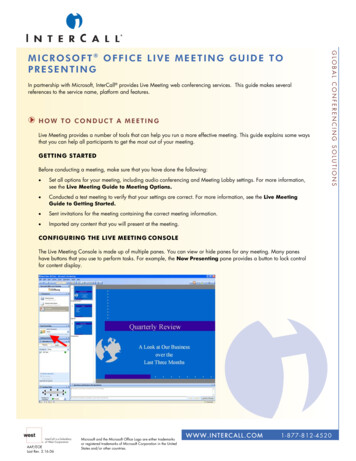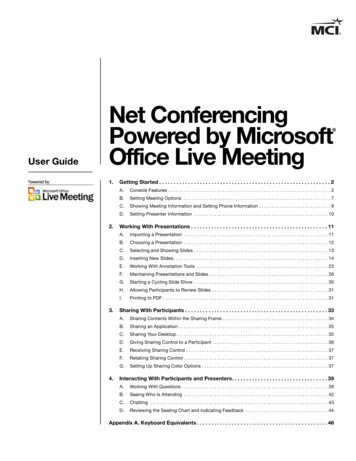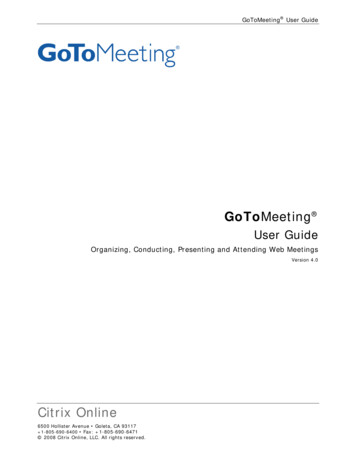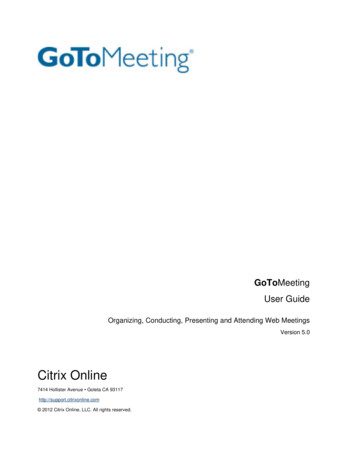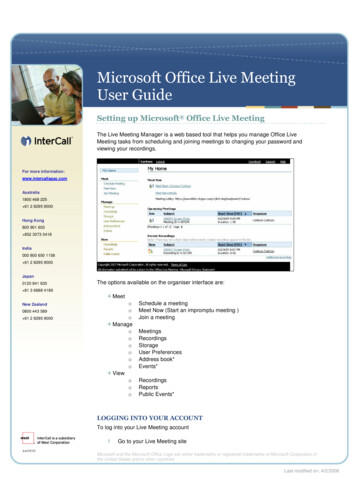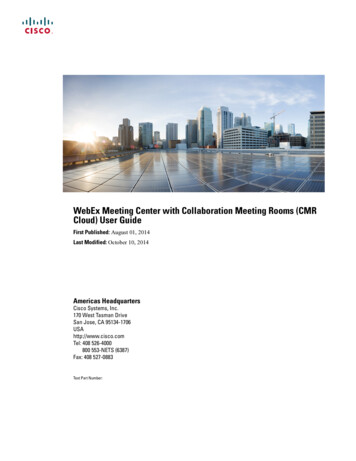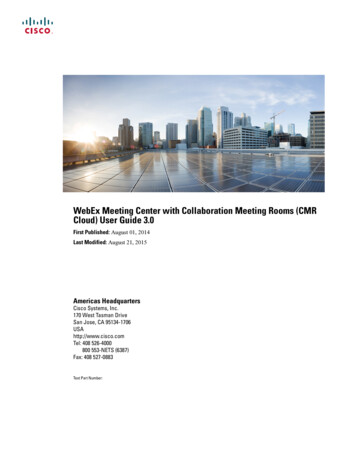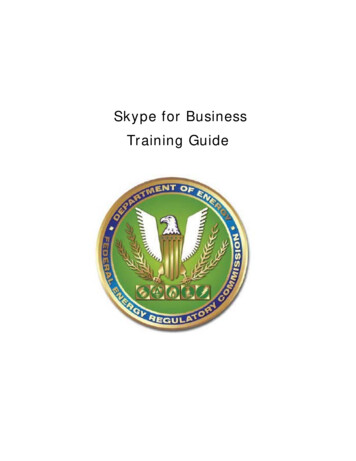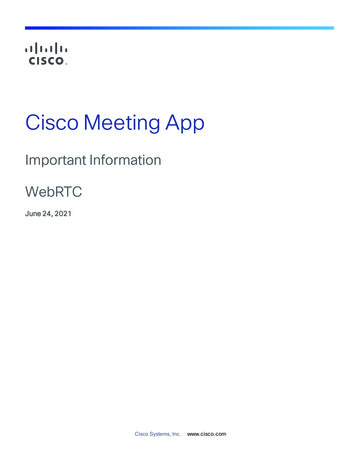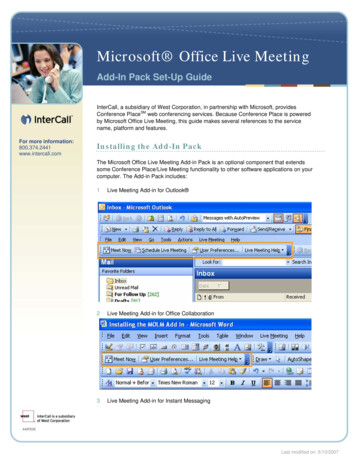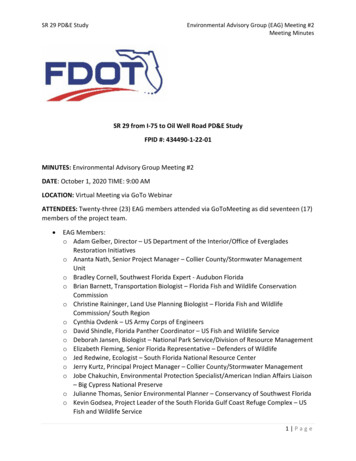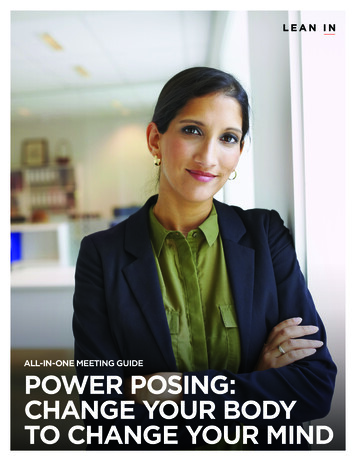
Transcription
ALL-IN-ONE MEETING GUIDEPOWER POSING:CHANGE YOUR BODYTO CHANGE YOUR MIND LeanIn.0rg, 20161
OverviewBody language affects our thoughts, feelings, and physiology. This meetingwill teach you how to use your body to increase your confidence in high-stakessituations when personal presence matters most.Meeting Goals Understand how your body language influences the way you think and feel aboutyourself Practice using your body to shift your mind-setPre-Meeting Prep Watch Amy Cuddy’s TED Talk, “Your Body Language Shapes Who You Are,”individually or as a group at leanin.org/power-pose Bring a copy of this PDF Bring your One Action Update (if you’re doing this)Brought to you in partnership with . . .Amy Cuddy, author of Presence and associate professor andHellman Faculty Fellow in the Negotiation, Organizations & MarketsUnit at Harvard Business School. She studies the origins andoutcomes of how we perceive and are influenced by other people. LeanIn.0rg, 20162
Meeting AgendaApprox. 1 hour 35 minutes for total meeting (based on a group size of ten members)1Check-In2Educational ActivitiesApprox. 20 minutesWarm up, catch up, and get goingp.4Approx. 50 minutesLearn from experts and one another Activity 1: Key Takeawaysp.5Approx. 5 minutesTake a few minutes to review the core strategies presented in the “Your BodyLanguage Shapes Who You Are” video Activity 2: Body Language AuditApprox. 20 minutesTake stock of your own body language Activity 3: Practicing for Success34Wrap-Upp.7Approx. 35 minutesIdentify your favorite power pose and when you might use itOne Actionp.5p.9Approx. 15 minutesThe little push you need to go for itp.11Approx. 10 minutesWhat’s next and a few final wordsp.13Optional WorksheetOne Action Updatep.15 LeanIn.0rg, 20163
Meeting GuideCheck-InWarm up, catch up, and get goingApprox. 20 minutesStep 1: IcebreakerGroup activity1 minute or less per memberAn icebreaker is a powerful tool to help us become present with one another and ourselves. One byone, fill in the sentence below and share it with your Circle. Listen carefully as each member takes aturn and say thank you when she’s finished. Avoid the urge to slip into conversation. I feel least powerful when . . . I feel most powerful when . . .Step 2: Member UpdatesGroup activity1 minute or less per memberOnce you’re warmed up, go around your Circle and share personal updates. As a general rule,personal updates should be brief and focus on big changes and important decisions in your life.(It’s OK not to have one every month!)If you have a One Action Update, share that with your Circle at the same time. (A One Action isone concrete action you committed to take at your last meeting. The goal is to step outside yourcomfort zone or practice a new skill.)For example, a member update might go like this: “Since our last meeting, I asked my boss for a bigassignment and got it. I’m thrilled but a little nervous [personal update]. For my One Action, I askedthat coworker I’ve been struggling with out for lunch. She immediately said yes, and I was surprisedby how easily we got along. I can see it helping in the office, and we’re going out for lunch againnext week—her invite! [One Action update].” LeanIn.0rg, 20164
Education ActivitiesLearn from experts and one anotherApprox. 50 minutes for all activitiesActivity 1: Key TakeawaysIndividual activity5 minutesAs you kick off today’s meeting, review the key takeaways from the video, “Your Body LanguageShapes Who You Are,” individually or as a group:Body language influences how others think and feel about youBody language is an important part of how we communicate, influencing everything from hiring andpromotion decisions to the outcomes of political races.Body language also influences how we think and feel about ourselvesStudies show that body language affects our thoughts, feelings, and physiology. For example,research has shown that just as being happy makes us smile, smiling makes us happy (aphenomenon known as the facial feedback effect).People use nonverbal cues to display powerExpressions of power involve expanding the body to take up space, while powerless positionsinvolve contracting or becoming smaller. (Check out Lean In’s “Power & Influence” video and guideat leanin.org/education/power-influence/ for more information on how to use body language toinfluence others.)We can measure physiological differences in powerful peoplePower activates the psychological “approach system”: powerful people are more action-oriented,assertive, confident, optimistic, and resilient. They also tend to have higher circulating levels oftestosterone (the assertiveness hormone) and lower levels of cortisol (the stress hormone). Thesehormones rapidly fluctuate in response to social cues in both women and men. LeanIn.0rg, 20165
Activity 1: Key Takeaways (cont.)You can change your mind-set using your bodyResearch suggests that posing can change your hormone levels. One study found that holding apower pose for two minutes increased testosterone by 19 percent and decreased cortisol by 25percent, mirroring the differences measured in powerful people.Power posing is effective in high-stakes situationsHigh-stakes situations (like job interviews, stressful social encounters, and public speakingengagements) offer great opportunities to practice reducing stress and increasing confidencethrough power poses.Fake it until you become itMany people experience “impostor syndrome,” or feeling like a fraud. They approach high-stakessituations with dread, execute them with anxiety, and leave them with regret. Power posing for justa minute or two can increase both your confidence and enthusiasm in these difficult situations. By“faking” your way through challenging moments, you’ll build organic confidence in your expertiseand abilities. It’s important to point out that the only person you’re tricking is yourself—you’retricking yourself into having the confidence to reveal the skills, knowledge, and competencies youalready possess. LeanIn.0rg, 20166
Activity 2: Body Language AuditApprox. 10 minutesTo better understand how your body can shape your mind-set, take stock of your body language inthis simple ten-minute exercise.Step 1: Check in with your bodyIndividual activity5 minutesWithout shifting or adjusting your posture, take note of how you are sitting. In the space below, describe the physical position of your body from head to toe. What are your head, neck, and shouldersdoing? How is your torso positioned? Where are your legs, knees, ankles, and feet?Next, check in with how you feel in this posture. What thoughts pop up when you hold your bodythis way? How would you describe your presence within the Circle at this moment? LeanIn.0rg, 20167
Activity 2: Body Language Audit (cont.)Step 2: Reflect on your body auditPair activity2 minutes per partner, 4 minutes totalBreak into pairs. Take two minutes each to answer a few of the questions below, sharing yourreflections on your body language with your partner. What observations did you make about your body language during the audit? Were you expandingor contracting in space? How did your body language impact your physical presence within the Circle? What connection did you find between your body language and how you felt? Were you posed in the way you typically hold yourself? If not, what was different and why? What did you learn about your own body language that may come in handy in the future? LeanIn.0rg, 20168
Activity 3: Practicing for SuccessApprox. 35 minutesThis activity will help you identify times when you might need to boost your confidence. You’ll alsopractice using power posing to change your mind-set.Step 1: Identify times when you need a confidence boostGroup activity2 minutes per member, 20 minutes totalA high school reunion. A public speech. A job interview. A stressful meeting with your boss. Theseare all moments when we feel like we’re being evaluated socially and when stress and intimidationcan hold us back. If you find yourself feeling hesitant to speak up in these situations or like you don’tbelong (even when your qualifications prove that you do!), you could probably use a confidence boost.Spend two minutes each describing a time when you could have used a confidence boost. What was the situation? Describe the physical sensations you associate with the situation (e.g., tightness in your stomach,fluttering in your chest). What was your reaction to the situation/your feelings? What did you do? Did your feelings affect your performance? LeanIn.0rg, 20169
Activity 3: Practicing for Success (cont.)Step 2: Practicing power posing and more subtle expansive posturesPair activityApprox. 15 minutesPower posing offers an effective tactic for boosting your confidence in preparation for a highstakes situation. (Note that using power poses in actual interactions is not effective, as it can beunnecessarily domineering. In interactions, adopt open, good postures that signals both confidenceand engagement.) In this activity, you’ll try out a power pose to see how it changes your outlook.Break into pairs. Spend about five minutes trying out each of the four poses below with your partner.Spend about a minute trying each pose and considering where you might see yourself using it. Wonder Woman: Stand with your hands on your hips and your feet shoulder width apart. V for Victory: Stand with your feet shoulder width apart and stretch your arms out into a V, as ifyou just crossed the finish line at a race. The President: Recline in your chair with your hands clasped behind your head. Prop your feet upor spread your knees wide to take up space. The CEO: Stand at the head of the table with your feet spread wide. Lean over and place yourhands on the table, keeping your chest pointing forward and your head held high.Next, discuss with your partner: Which pose did you like best? Which pose(s) would you do in public? Which would you do in private? Which pose felt most natural? If none of them felt natural, why do you think that is?Now pick your favorite pose and hold it for a minute (or as long as feels comfortable to you).Finally, spend two minutes sharing your experience with your partner. Use these questions to help you: How do you feel after trying out your favorite power pose? How has your body changed after holding the power pose in comparison with the body audit? LeanIn.0rg, 201610
One ActionThe little push you need to go for itApprox. 15 minutesWe recommend you close every meeting by committing to a “One Action”—one concrete thing you’regoing to do before your next Circle meeting to step outside your comfort zone or practice a new skill.Step 1: Identify the action you’re going to takeIndividual activity5 minutesAs we’ve discussed, power posing is about faking it until you become it. Internalizing the feelingsof power from these poses will help you be your best self, even in high-stakes situations. It’s aboutincreasing your personal power by allowing your body to “trick” your mind into feeling confidentand open. When we are in this state, we can access and bring forth our best qualities and abilitieswhen we most need to. We can be present.Consider an upcoming high-stakes situation in your life. How can you use power posing before thesituation to help you bring your fullest, most confident self? LeanIn.0rg, 201611
One Action (cont.)Step 2: Share your One Action with your CircleGroup activity1 minute or less per member, 10 minutes totalOne by one, go around your Circle and complete the following statement: In the next month, I plan to use my body to change my mind-set during . . .Move quickly from member to member, and consider cheering on one another as you go.Housekeeping Note: We recommend you give an update on your One Action during your nextmeeting. On page 15 of this PDF, you’ll find an optional worksheet to help you prepare yourupdate. LeanIn.0rg, 201612
Wrap-UpWhat’s next and a few final wordsApprox. 10 minutesStep 1: Finalize logistics of your next meetingGroup activity10 minutesBefore you break, make sure you have the basics covered for your next meeting, including day andtime, location, and food and drink responsibilities. Decide what you’re going to do when you get together or who is going to send out ideas. You may also want to talk through what worked—and whatdidn’t—in today’s meeting so you can brainstorm improvements going forward.Step 2: Close on an energetic and inspirational noteGroup activity1 minutes or lessAs you wrap up the meeting, look around the group. People might be taking up more space thanwhen you first came together, or the group dynamic may have shifted to become more energetic.Then check in with yourself. How do you feel after practicing power posing? Go around the Circleand share one word that sums up how you feel in this moment. LeanIn.0rg, 201613
Congratulationson a great meeting.See the following pages for a One Action Update Worksheet. LeanIn.0rg, 201614
One Action UpdateUse the following prompts to prepare your One Action Update before your next meeting, tomaximize your time with your Circle. Prior to power posing before my high-stakes situation, I felt . . . After power posing, I felt . . . After the situation concluded, I felt . . . In the end, I learned that . . . LeanIn.0rg, 201615
through power poses. Fake it until you become it Many people experience "impostor syndrome," or feeling like a fraud. They approach high-stakes situations with dread, execute them with anxiety, and leave them with regret. Power posing for just a minute or two can increase both your confidence and enthusiasm in these difficult situations. By

